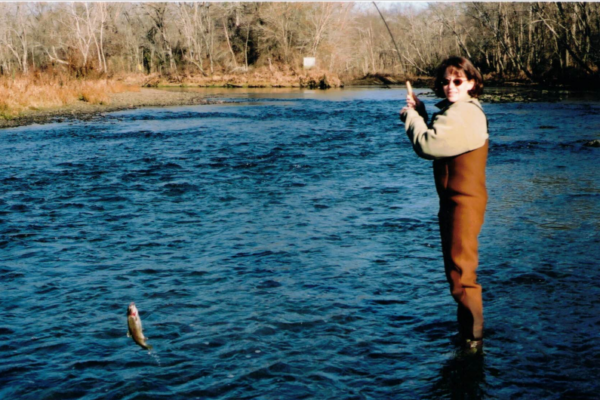Kari Blaho-Owens, Ph.D., is Perficient’s Director of Pharmacovigilance, Safety, and Regulatory Affairs. She leads a team that provides PV, regulatory, risk management knowledge, and consulting to pharma and CROs. Perficient also hosts PV-related applications, configure, validate and maintain PV adverse event databases, and reporting solutions. At the end of the day, we contribute to patient safety by providing the means to ensure that drugs are safe and effective. Kari has more than 25 years of experience building and supporting global safety and regulatory initiatives for pharmaceutical, medical device, animal health, and clinical research organizations (CROs).
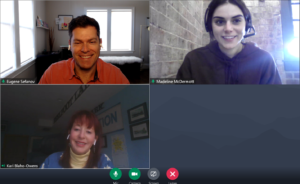
Kari Blaho-Owens joins Madeline McDermott and Eugene Sefanov for a Microsoft Teams Chat
“Huntin’, Fishin’, and Lovin’ Every Day”
Madeline McDermott: First things first. Where were you born?
Kari Owens: I was born in Coral Gables, Florida.
MM: Did you spend most of your childhood there?
KO: My family moved pretty often when I was little. I lived in Mississippi and Texas, and when I was about 10 or 11, we settled in a small, rural town in Arkansas. There wasn’t even a McDonald’s nearby until I was in high school. That’s where I grew up and consider home.
MM: Where do you live currently?
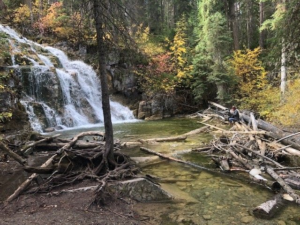
Kari taking a photo in Sunday Falls, in Stryker, Montana
KO: Eureka, Montana. It’s such a beautiful mix of people, land, culture. It’s awesome!
MM: What’s the population of Eureka?
KO: There are around 1,300 people – but it’s not as rural as you’d think. We’re just very spread out.
MM: Where did you live before Montana?
KO: Before moving to Montana, I lived in Bennett, North Carolina. North Carolina really morphed in a short period of time because a lot of technology and pharma moved there.
MM: Why did you end up moving away from North Carolina?
KO: We were looking for a place that was different. I wanted to live on a river where I could fly fish, hunt, and take pictures of the amazing scenery. We were fortunate to find a place on the Tobacco River. There is a lot of history here, and the people are lovely. And it wouldn’t be possible to live here if it weren’t for my role at Perficient. The company and role allow me to work anywhere.
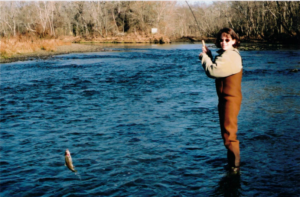
Kari catches a little red trout
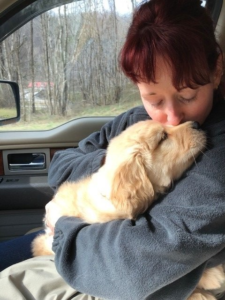
Kari when she brought home her golden retriever puppy, Trip
MM: You must really love nature.
KO: I think that’s the thing that makes living here so awesome; you can look out at any time of the day and see all this wildlife.
We had a group of deer that came through last week. I was on my porch giving out some dry corn to the birds when I saw them. I held out my hand super still, and a doe came up and ate some of the corn out of my hand. And then she put her head on my shoulder. It was just amazing.
***
From White-Knuckle Flying to Volunteering
MM: I see that the sign behind you says, “Shelby Aviation.” Tell me about that.
KO: When I was in academia and traveling quite a bit, I was a white-knuckle flier. Let’s just say physics and math are unpleasant for me. To confront this, I thought I’d go to ground school to get a better understanding of the physics and math behind flying and how a 250,000-pound metal tube stays in the air. I thought it would make me more comfortable.
I then thought I’d buy three hours of airtime with an instructor to see if I couldn’t “kiss the dragon.” I spent the first 45 minutes sitting on my hands. My instructor finally had me take the yolk for a bit.
Something happens while flying…it’s like when you’re in a boat and you hit a backwash. You can just feel it. Once you’ve done that in the air, it’s like a sickness. There was no stopping after that.
I started flying with these guys at Shelby Aviation in Millington, Tennessee, where I had a Navy instructor who taught me more, let’s just say, new vocabulary, than I had ever heard in my life. He was an extraordinary pilot.
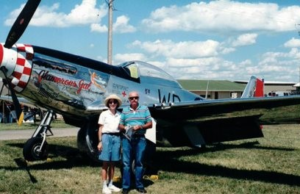
Kari and her air instructor at the world’s largest airshow and in front of a P51 Mustang airplane
I went on to get my private, instrument rating, then my multi-engine commercial industry rating. Next, I would like to earn my seaplane rating because there are lots of lakes in the mountains here. I’d also like to try flying a helicopter.
It’s never been just about flying for the — what they used to call the “$100 hamburger.” By the way, it’s more like the “$400 hamburger” now, when you consider inflation.
I got involved volunteering with Veterans Airlift Command, an organization that provides free air transportation to those wounded in combat, as well as their families, for medical care. I also flew with Angel Flight, an organization that flies patients to points of care for medical treatment. There was also a third group that I helped support, too, that was formed right after 9/11, and its mission was to recruit and train general aviation pilots to fly supplies or whatever else was needed in case we encountered that type of crisis again.
MM: Did you do a lot of those types of flights over the years?
KO: I did as much as time allowed. While I lived in Atlanta, we flew veterans with disabilities to Shepherd Center, a patient rehabilitation hospital for the military wounded.
When we lived in Tennessee, we flew a lot of kids to St. Jude Children’s Research Hospital.
During Hurricane Katrina, we flew a lot of supplies down from Memphis as far down south as we could to get them to the National Guard.
It was a real blessing to be able to do this. These groups opened a lot of opportunities, and through them, I have met so many incredible people.
There is a lot you can do with general aviation, and I’d encourage anyone who dreams of flying to try it. Like many things in life, it may not be what you think it is, but it has been an extraordinary privilege and blessing.
***
“No Three-Year-Old Wakes Up and Thinks ‘I want to work in pharmacovigilance.’”
MM: What was your first job?
KO: My first job or my worst job?
MM: Both!
KO: My first job was nannying and housekeeping for a family in my hometown in Arkansas. The shortest job I ever had was a waitress – it’s one of the most difficult jobs in the world – I lasted four days.
MM: What was your first corporate job?
KO: My first corporate job was with Schering-Plough in the consumer and OTC health division. Right after they approved Claritin to be sold over the counter, the company needed a pharmacovigilance group that could integrate with its medical information and global PV group. I was hired to build a team that could support Claritin and manage the legacy products in the rest of the Schering-Plough line. The company had everything from wart removers to laxatives. You can imagine the number of cases we got.
MM: How did you end up getting into the pharmacovigilance space?
KO: No three-year-old wakes up and thinks, “I think I want to work in pharmacovigilance.” I worked in the inner-city emergency department at the Elvis Presley Memorial Trauma Center as the research director in the ER. It’s a level 1 trauma center that takes patients from a four-state area. We had a research program, and that’s when I got involved working on clinical studies around toxicology, envenomations, and overdose. I also worked closely with a forensics team that we built from scratch.
There is this vast amount of data available to you when you’re right there at the point of patient care. For example, sometimes patients would come in because of out-of-control blood pressure, and we didn’t immediately know the reason for that. We started collecting data on this and realized that they had back pain and were taking nonsteroidals, which we now know interact with the disease and hypertension medications.
Observing this data and identifying these trends in this position led me to pharmacovigilance.
Pharmacovigilance is not just about observing, although it used to be. Today, it’s about being proactive and recognizing patterns that might indicate something is unusual and worth investigating further.
The faster we can get information out there, in a digestible format, to the people who are caring for patients, the better patient care that we will be able to provide.
I mean, look at the miraculous way pharma has been able to roll out the COVID-19 vaccines. In record time, we have three safe and effective vaccines. Twenty years ago, this wouldn’t have been possible.
It’s hard to remember this when you’re in pharmacovigilance. You’re usually not there to see a patient walking out of the ER or out of the hospital. I always try to remember that, in PV, we’re touching lives in ways we don’t always see.
MM: You mentioned that you worked with forensics. Can you talk a little about that?
KO: Since we were an inner-city emergency department, we saw a lot of severe reactions from drug abuse, mostly to cocaine. I even accompanied the Shelby County DEA on drug raids and acquired samples, so my colleagues and I could study the difference in the cocaine from different locations. What’s interesting is that we found there is no dose-response effect in cocaine. This kind of data helped the police better recognize when someone in their custody needed to be seen to minimize the risk of in-custody deaths.
MM: That must have been tough to observe. Did you get burned out from that kind of work?
KO: You see a lot of patients who do the same thing time and time again. I did get burned out. Too many late nights. It does take a toll on you. Hats off to those healthcare workers who work those long hours in acute care settings. It can be heart-wrenching.
MM: Let’s talk about what you’re doing day-to-day. What is the last project you completed?
KO: Well, there’s never just one project starting or completing. We recently just finished a safety system upgrade for a client, and we created custom reports for them, so the data could be used in a more meaningful way. We also recently helped another client with their intake data flows and processes.
MM: What was the client’s intake process like, and what did we recommend?
KO: We essentially were able to simplify and expedite the flow of data and enhance compliance. We helped the client eliminate multiple redundant steps in its intake process. These steps were confusing, took too long, and had too many people involved at every step of the way. Rather than going through a more direct line from A to B, all these detours were occurring. We took away the barriers and said we would get to the same endpoint easier, faster, and more accurately.
MM: Is there anything we’re doing right now that you want readers to know?
KO: Many people, even some of our clients, don’t realize the breadth of our PV team. I’ll share two examples:
We look at the pharmacovigilance ecosystem holistically. That starts with the intake of the adverse event or at the point where medical information is distributed, and it ends with the data analysis. We build and deploy intelligent processes and solutions that save people time and help them get to valuable and digestible data quickly to do their jobs more efficiently. At the moment, we’re helping organizations understand how they can use AI and natural language processing to support their medical information and call center operations. Things like virtual agents and conversational chatbots are very hot right now.
This brings me to my next point. A lot of what we do at Perficient is education. If I’m at a pharma, device, CRO, or animal health company and work a challenging 50-60 hours a week just to keep up with data, when do I have time to think about improving how my company or I work?
Unfortunately, most life sciences companies don’t have time to focus on improvements. But it’s important to sit down and talk through a problem and expand conversations into areas that feed into the pharmacovigilance ecosystem. There is a great need to better understand the landscape, the rules, and the pain points so that we can fix things practically and logically. The fact that there are so many talented people at Perficient has really helped make such conversations conducive. Fortunately, we have people here who can look at things from various perspectives. I believe it helps set us apart from our competitors.
MM: What interests you most about the industry?
KO: I get excited about working through the complexity of the drug safety regulatory network, keeping abreast of the challenges of data, and offering common-sense solutions. I’m a nerdy scientist at heart; I love keeping up with new therapeutic areas and how PV impacts the quality of patients’ lives, and how much we depend on technology. At the end of the day, we contribute to patient safety by providing the means to ensure that drugs are safe and effective.
MM: What impact will technology have in the PV space?
KO: One example is how technology helps us to understand and analyze AE data. We will need to work smarter, not harder. While there are many technology solutions available, the key to success is pairing the right solution as a fit-for-purpose agile solution. One of the biggest wake-up calls has been the value of PV data during the COVID-19 pandemic. Many of the early treatments tried in COVID-19 patients were based on historical knowledge, gained in part from legacy pharmacovigilance data.
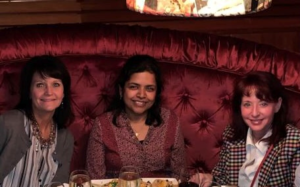
Vicky Green, Prabha Ranganathan, and Kari at a business dinner
***
Rapid-Fire Questions
MM: What are your favorite brands or companies?
KO: I am very picky about where something is made. There are things that I will not buy if it is made in a certain geographic area.
My favorite brand of everyday cabernet is from BV Rutherford out of Napa, and for special occasions, Rothschild from the Bordeaux region of France.
My favorite brand of aircraft is Beechcraft; they make some of the most awesome innovative aircraft.
My favorite truck brands are Ford and Toyota.
My favorite perfume brand is Bond No. 9 New York.
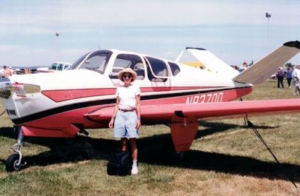
Kari with a VTail Beech Bananza Airplane
MM: What about your favorite genre of music?
KO: I love country music, and I absolutely love Opera – Puccini is my absolute favorite composer for Opera and Mozart for classical music. And I feel happy listening to Bluegrass like Sweet Potato Pie.
MM: Coffee or tea?
KO: Definitely tea. Iced. Unsweet. Unsweet iced tea.
MM: What is the closest chain business near you?
KO: It would be a grocery store in Whitefish, MT. There are no fast-food places here, though, just local places, and they’re phenomenal. You wouldn’t believe the kind of meat we have.
It’s no secret our success is because of our people. No matter the technology or time zone, our colleagues are committed to delivering innovative, end-to-end digital solutions for the world’s biggest brands, and we bring a collaborative spirit to every interaction. We’re always seeking the best and brightest to work with us. Join our team and experience a culture that challenges, champions, and celebrates our people.
Visit our Careers page to see career opportunities and more!
Go inside Life at Perficient and connect with us on LinkedIn, YouTube, Twitter, Facebook, and Instagram.
